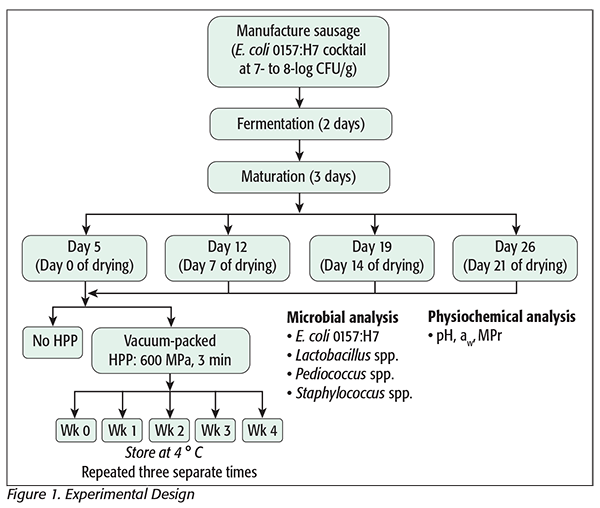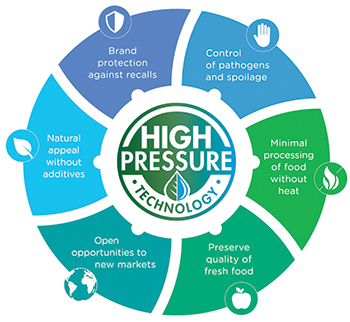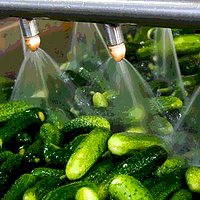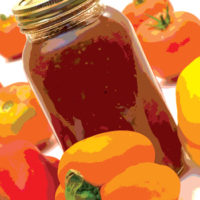Dry fermented sausages (DFSs) are a class of traditional ready-to-eat (RTE) meat products that are manufactured without thermal processing and are preserved by a combination of acidification as a result of lactic acid fermentation by the added starter culture, controlled drying, resulting in the reduction in water activity (aw), and the addition of curing salts, nitrate, nitrites, and spices, resulting in a shelf-stable product for extended periods when stored at room temperature. Shelf-stable DFSs have a pH, aw, and moisture protein ratio (MPr) between 4.6 and 5.3, 0.85 and 0.90, and 1.9 and 2.3, respectively. Although DFSs have been generally regarded as safe due to their low pH and aw, there have been several instances where consumption of pre-sliced dry salami has been linked to sickness due to Escherichia coli O157:H7 infection. Hence, regulations require that DFS manufacturers demonstrate that the manufacturing process results in a 5-log inactivation of E. coli O157:H7. The combination of low pH and low aw was found to significantly reduce E. coli O157:H7 (1- to 2-log CFU/g) but was insufficient to eliminate the pathogen when present at high levels. In most cases, although the fermented sausages reach the pH, aw, and MPr to be considered shelf stable, the fermentation process is not sufficient to cause the required 5-log inactivation of E. coli O157:H7 and requires extended drying to achieve the required inactivation of the pathogen. This extended drying in most cases results in a product that is extremely dry and unacceptable for consumption. Therefore, a nonthermal intervention that could enhance and achieve the 5-log pathogen inactivation without the need for extended drying and loss in quality would be very useful.
Researchers at Agriculture and Agri-Food Canada examined the effectiveness of using high-pressure processing (HPP) during the drying of the fermented sausages to achieve the highest inactivation of E. coli O157:H7. HPP is a “cold pasteurization” technique by which liquid or solid food products already sealed in their final packages are introduced into a vessel and subjected to isostatic pressures between 300 and 600 MPa transmitted through water. Pressures can be applied at controlled temperatures, and treated foods retain the characteristics of the fresh product with very little change to sensorial and nutritional properties, depending on the pressure applied, and have been shown to inactivate vegetative cells of bacteria, viruses, yeasts, molds, and parasites.[1] However, the composition of the foods can have a dramatic effect on the inactivation of microorganisms by HPP. Foods rich in proteins, carbohydrates, and lipids have a protective effect on microorganisms during pressure treatment. In addition, pH and aw of food matrices also have dramatic effects on the inactivation of bacteria. The efficacy of microbial inactivation by pressure is reduced when the aw of the foods is lowered. The nature and concentration of the solute used to reduce the aw also dramatically affects the baroprotection of microorganisms observed during HPP of foods with a low aw.[2] HPP has been successfully used to inactivate pathogens on RTE meats such as DFSs and ham. However, in all these cases, HPP had been used to inactivate pathogens on sliced finished products after the fermentation, drying, and maturation steps but has never been used as part of the fermentation and dry-curing processes.
 Equipped with this knowledge, researchers prepared sausage batter containing 18.46 percent fat and mixed a ground pork and beef blend, commercial meat fermentation starter culture, and a five-strain E. coli O157:H7 cocktail (outbreak-associated strains of human and food origin) to obtain a final concentration of 7- to 8-log CFU/g. Salt (2.98%), salami cure (0.73%), and spices were added during the mixing, and the mixed batter was stuffed into 35-mm fibrous cellulose casings to make sausages of lengths that were at least twice the diameter. The sausages were fermented at 26 °C and 88 percent relative humidity (RH) and then dried by a stepwise reduction in temperature and RH to 14 °C and 75 percent, respectively, and then held for 21 days. After fermentation (when the pH of the sausages is less than 5.0), the sausages were transferred to the drying cabinet, and six sausages removed weekly, vacuum-packaged, and subjected to high-pressure treatment at 600 MPa for 3 minutes and then stored at 4 °C for up to 4 weeks. The untreated and pressure-treated sausages were then subjected to microbial and physicochemical analyses (Figure 1).
Equipped with this knowledge, researchers prepared sausage batter containing 18.46 percent fat and mixed a ground pork and beef blend, commercial meat fermentation starter culture, and a five-strain E. coli O157:H7 cocktail (outbreak-associated strains of human and food origin) to obtain a final concentration of 7- to 8-log CFU/g. Salt (2.98%), salami cure (0.73%), and spices were added during the mixing, and the mixed batter was stuffed into 35-mm fibrous cellulose casings to make sausages of lengths that were at least twice the diameter. The sausages were fermented at 26 °C and 88 percent relative humidity (RH) and then dried by a stepwise reduction in temperature and RH to 14 °C and 75 percent, respectively, and then held for 21 days. After fermentation (when the pH of the sausages is less than 5.0), the sausages were transferred to the drying cabinet, and six sausages removed weekly, vacuum-packaged, and subjected to high-pressure treatment at 600 MPa for 3 minutes and then stored at 4 °C for up to 4 weeks. The untreated and pressure-treated sausages were then subjected to microbial and physicochemical analyses (Figure 1).
.png) Results indicate that as the fermented sausages continued to dry, the inactivation of E. coli O157:H7 as a result of HPP was significantly reduced (Table 1). For instance, on day 0 of drying, when the aw and MPr of the fermented sausages were 0.95 and 2.22 (MPr required for being considered shelf stable), respectively, the inactivation of E. coli O157:H7 following fermentation and drying was 1.54-log CFU/g. However, following high-pressure treatment, E. coli O157:H7 inactivation was enhanced by 4.94-log CFU/g, resulting in an overall 6.48-log inactivation. After 7 days of drying, when the aw and MPr of the sausages fell to 0.85 and 1.35, respectively, inactivation of E. coli O157:H7 due to HPP was only 2.42 logs. The inactivation of E. coli O157:H7 due to HPP was further reduced as the sausages continued to dry (Table 1). High-pressure treatment of the fermented sausages did not significantly affect the population of lactic acid bacteria in the starter culture used. Examination of high pressure-treated sausages stored at 4 °C revealed that E. coli O157:H7 could be recovered a week into storage, but the numbers were not significantly different from those in sausages examined right after high-pressure treatment. No E. coli O157:H7 was recovered from any high pressure-treated sausage thereafter in weeks 2, 3, and 4 of storage at 4 °C.
Results indicate that as the fermented sausages continued to dry, the inactivation of E. coli O157:H7 as a result of HPP was significantly reduced (Table 1). For instance, on day 0 of drying, when the aw and MPr of the fermented sausages were 0.95 and 2.22 (MPr required for being considered shelf stable), respectively, the inactivation of E. coli O157:H7 following fermentation and drying was 1.54-log CFU/g. However, following high-pressure treatment, E. coli O157:H7 inactivation was enhanced by 4.94-log CFU/g, resulting in an overall 6.48-log inactivation. After 7 days of drying, when the aw and MPr of the sausages fell to 0.85 and 1.35, respectively, inactivation of E. coli O157:H7 due to HPP was only 2.42 logs. The inactivation of E. coli O157:H7 due to HPP was further reduced as the sausages continued to dry (Table 1). High-pressure treatment of the fermented sausages did not significantly affect the population of lactic acid bacteria in the starter culture used. Examination of high pressure-treated sausages stored at 4 °C revealed that E. coli O157:H7 could be recovered a week into storage, but the numbers were not significantly different from those in sausages examined right after high-pressure treatment. No E. coli O157:H7 was recovered from any high pressure-treated sausage thereafter in weeks 2, 3, and 4 of storage at 4 °C.
These results suggest that the inactivation of E. coli O157:H7 in DFSs following HPP is most effective when high-pressure treatments are applied prior to the fermented sausages reaching an aw of less than 0.90 or an MPr in the range of 1.9 to 2.3. These findings highlight some very useful applications of HPP during the manufacture of fermented, dry-cured RTE meats. First, HPP can be used in conjunction with fermentation and dry curing to enhance pathogen inactivation. Secondly, high-pressure treatment of fermented sausages with a pH and aw of 5.0 and 0.90, respectively, which happens very early during the drying, could dramatically reduce the duration of drying without compromising safety. For instance, taking the fermentation and dry-curing processes used here and subjecting the sausages to HPP at 600 MPa for 3 minutes after the sausages reach a pH of 5.0 and before the aw falls below 0.90, a shelf-stable and safe product can be successfully manufactured within 10 to 12 weeks, which is a significant reduction in the DFS production time. Meat processors can easily incorporate HPP without undertaking any significant modification to their fermentation and dry-curing processes to produce a safe and shelf-stable product.
S. Balamurugan, Ph.D., is a research scientist at Agriculture and Agri-Food Canada’s Guelph Research and Development Centre. His research focuses on the generation of scientific evidence to support food safety guidelines, policies, and regulations.
References
1. Buzrul, S, et al. 2007. “Thermal and Chemical Inactivation of Lactococcal Bacteriophages.” Food Sci Technol 40(10):1671–1677. doi: http://dx.doi.org/10.1016/j.lwt.2007.01.002.
2. Balamurugan, S, et al. 2016. “Effect of Salt Types and Concentrations on the High-Pressure Inactivation of Listeria monocytogenes in Ground Chicken.” Int J Food Microbiol 218:51–56.

 Hiperbaric, a worldwide manufacturer of HPP equipment, appointed a group of HPP-specialized scientists to its Applications and R&D department to actively collaborate in research activities for the continuous improvement of HPP RTE meats, providing a link between research and industrial applications. Recent projects investigate the effects of RTE meat formulations that aim to establish a safe harbor for HPP, as well as the evaluation of spoilage microbiota inherently present in meats as a natural approach to control growth of spore-forming microorganisms, such as Clostridium spp., and reduce the salt content in RTE meat formulations.
Hiperbaric, a worldwide manufacturer of HPP equipment, appointed a group of HPP-specialized scientists to its Applications and R&D department to actively collaborate in research activities for the continuous improvement of HPP RTE meats, providing a link between research and industrial applications. Recent projects investigate the effects of RTE meat formulations that aim to establish a safe harbor for HPP, as well as the evaluation of spoilage microbiota inherently present in meats as a natural approach to control growth of spore-forming microorganisms, such as Clostridium spp., and reduce the salt content in RTE meat formulations.


